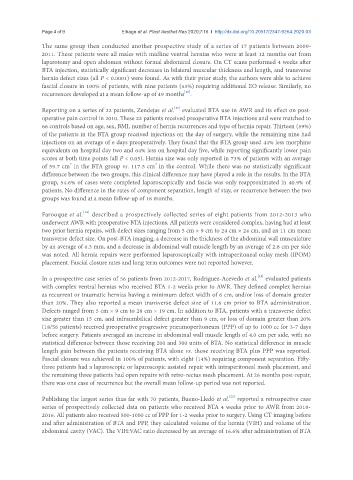Page 164 - Read Online
P. 164
Page 4 of 9 Elhage et al. Plast Aesthet Res 2020;7:16 I http://dx.doi.org/10.20517/2347-9264.2020.03
The same group then conducted another prospective study of a series of 17 patients between 2009-
2011. These patients were all males with midline ventral hernias who were at least 12 months out from
laparotomy and open abdomen without formal abdominal closure. On CT scans performed 4 weeks after
BTA injection, statistically significant decreases in bilateral muscular thickness and length, and transverse
hernia defect sizes (all P < 0.0001) were found. As with their prior study, the authors were able to achieve
fascial closure in 100% of patients, with nine patients (53%) requiring additional EO release. Similarly, no
[16]
recurrences developed at a mean follow-up of 49 months .
[17]
Reporting on a series of 22 patients, Zendejas et al. evaluated BTA use in AWR and its effect on post-
operative pain control in 2010. These 22 patients received preoperative BTA injections and were matched to
66 controls based on age, sex, BMI, number of hernia recurrences and type of hernia repair. Thirteen (59%)
of the patients in the BTA group received injections on the day of surgery, while the remaining nine had
injections on an average of 6 days preoperatively. They found that the BTA group used 44% less morphine
equivalents on hospital day two and 64% less on hospital day five, while reporting significantly lower pain
scores at both time points (all P < 0.05). Hernia size was only reported in 73% of patients with an average
2
2
of 59.7 cm in the BTA group vs. 117.5 cm in the control. While there was no statistically significant
difference between the two groups, this clinical difference may have played a role in the results. In the BTA
group, 54.6% of cases were completed laparoscopically and fascia was only reapproximated in 40.9% of
patients. No difference in the rates of component separation, length of stay, or recurrence between the two
groups was found at a mean follow-up of 18 months.
[18]
Farooque et al. described a prospectively collected series of eight patients from 2012-2013 who
underwent AWR with preoperative BTA injections. All patients were considered complex, having had at least
two prior hernia repairs, with defect sizes ranging from 5 cm × 9 cm to 24 cm × 24 cm, and an 11 cm mean
transverse defect size. On post-BTA imaging, a decrease in the thickness of the abdominal wall musculature
by an average of 6.3 mm, and a decrease in abdominal wall muscle length by an average of 2.8 cm per side
was noted. All hernia repairs were performed laparoscopically with intraperitoneal onlay mesh (IPOM)
placement. Fascial closure rates and long term outcomes were not reported however.
[19]
In a prospective case series of 56 patients from 2012-2017, Rodriguez-Acevedo et al. evaluated patients
with complex ventral hernias who received BTA 1-2 weeks prior to AWR. They defined complex hernias
as recurrent or traumatic hernias having a minimum defect width of 6 cm, and/or loss of domain greater
than 20%. They also reported a mean transverse defect size of 11.6 cm prior to BTA administration.
Defects ranged from 5 cm × 9 cm to 28 cm × 19 cm. In addition to BTA, patients with a transverse defect
size greater than 15 cm, and infraumbilical defect greater than 9 cm, or loss of domain greater than 20%
(18/56 patients) received preoperative progressive pneumoperitoneum (PPP) of up to 1000 cc for 3-7 days
before surgery. Patients averaged an increase in abdominal wall muscle length of 4.0 cm per side, with no
statistical difference between those receiving 200 and 300 units of BTA. No statistical difference in muscle
length gain between the patients receiving BTA alone vs. those receiving BTA plus PPP was reported.
Fascial closure was achieved in 100% of patients, with eight (14%) requiring component separation. Fifty-
three patients had a laparoscopic or laparoscopic assisted repair with intraperitoneal mesh placement, and
the remaining three patients had open repairs with retro-rectus mesh placement. At 26 months post-repair,
there was one case of recurrence but the overall mean follow-up period was not reported.
[21]
Publishing the largest series thus far with 70 patients, Bueno-Lledó et al. reported a retrospective case
series of prospectively collected data on patients who received BTA 4 weeks prior to AWR from 2010-
2016. All patients also received 500-1000 cc of PPP for 1-2 weeks prior to surgery. Using CT imaging before
and after administration of BTA and PPP, they calculated volume of the hernia (VIH) and volume of the
abdominal cavity (VAC). The VIH:VAC ratio decreased by an average of 16.6% after administration of BTA

